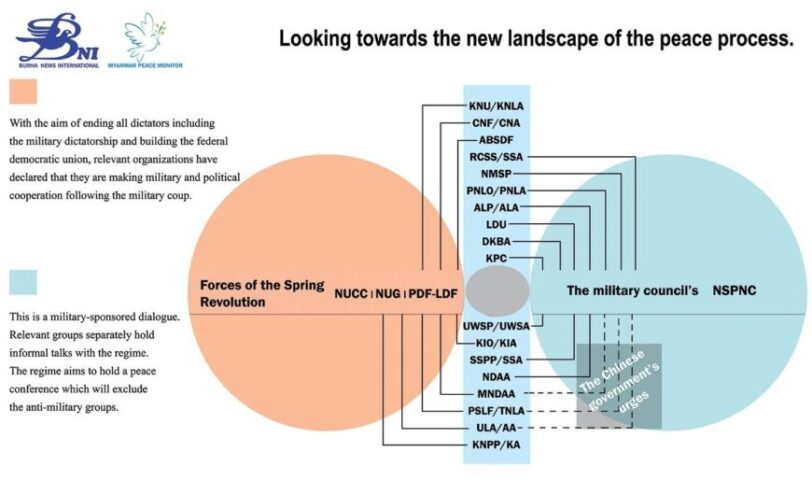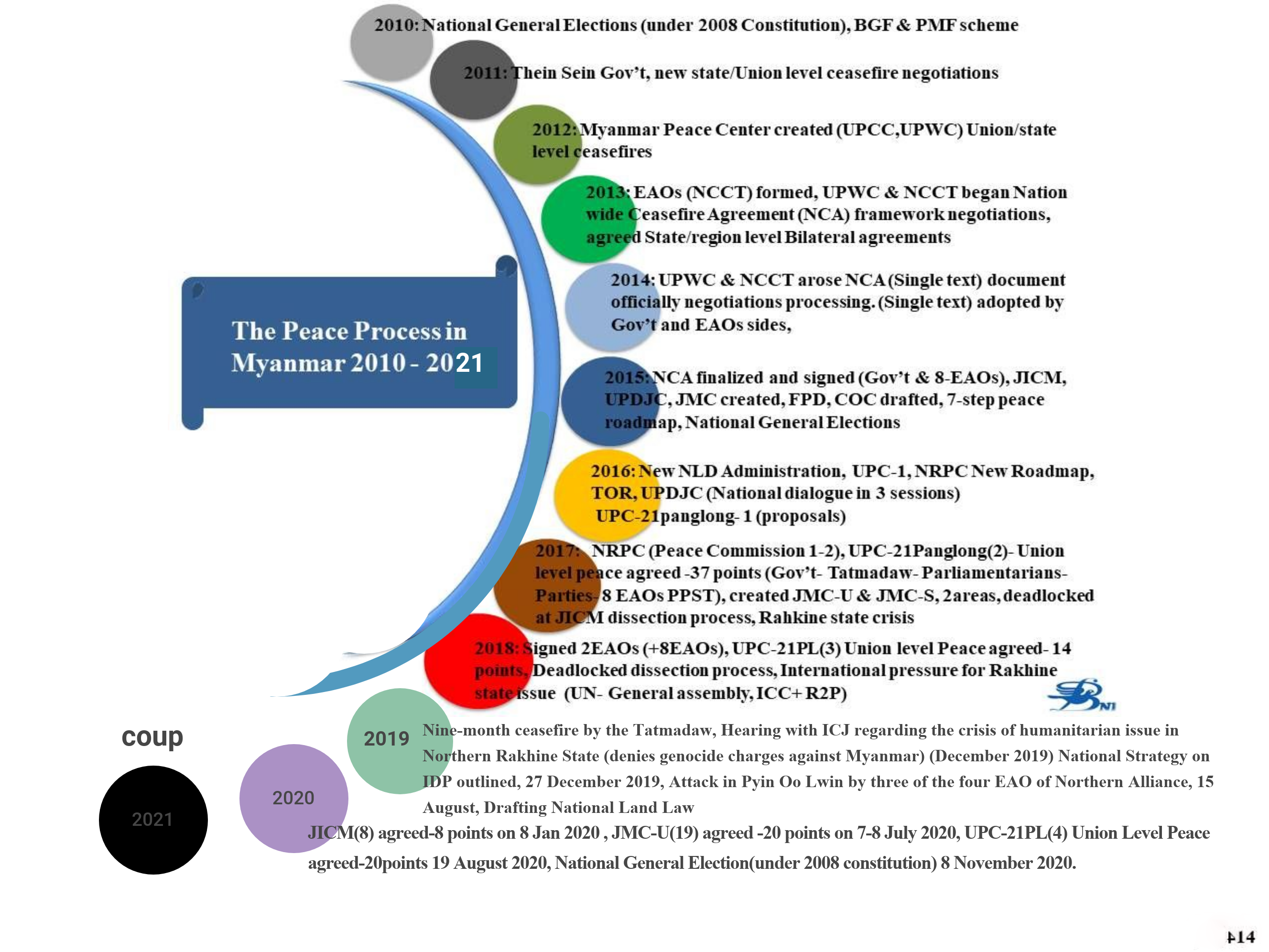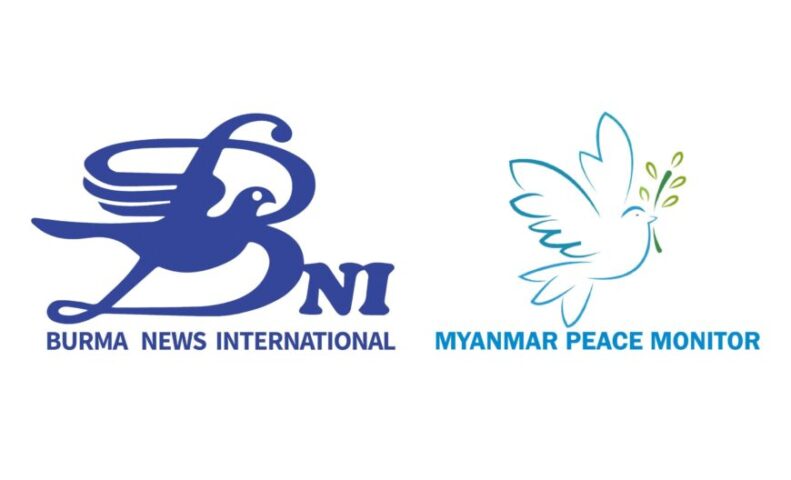

NLD Gov’t (Since – 2016 – 2021)
led by Daw Aung San Su Kyi (NLD Gov’t) through National Reconciliation and Peace Center (NRPC) replaced for Myanmar Peace Center (MPC).
NCA Ceasefire (10) groups: (since, 2015)
UNFC members (2009 formed)
- LDU, Lahu Democratic Union (NCA-Signed, 2018, Feb)
- NMSP, New Mon State Party (NCA- Signed 2018, Feb)
UNFC Former members
- KNU, Karen National Union (resigned from UNFC, 2014)
- CNF, Chin National Front (suspended from UNFC, 2015, Nov)
- PNLO, PaO National Liberation Organization (suspended from UNFC, 2015 Nov)
Non- UNFC members
- ALP – Arakan Liberation Party
- ABSDF – All Burma Students’ Democratic Front
- DKBA – Democratic Karen Benevolent Army
- RCSS/SSA – Restoration Council of Shan State/ Shan State Army
- KNU/KNLA(PC) – Karen National Union/ Karen National Liberation Army (Peace Council)
Non-Ceasefire groups:
UNFC members:
- KNPP, Karenni National Progress party
- ANC, Arakan National Council
FPNCC members (2017 formed)
- KIO/KIA – Kachin Independence Organization/ Kachin Indepednence Army
- SSPP/SSA – Shan State Progress Party/Shan State Army (suspending from UNFC(2017)/ resigned yet)
- ULA/AA – United League of Arakan/Arakan Army
- WNO – Wa National Organization
- UWSA – United Wa State Army
- PSLF/TNLA – Palaung State Liberation Front / Ta-ang National Liberation Army
- MNDAA – National Democratic Alliance Army
Peace Process Under NLD Government
In the 2015 General Election, the NLD party won by landslide of votes, which started their legitimate rule. On March 15, 2016, U Htin Kyaw was elected as the president during the Pyidaungsu Hluttaw Meeting. To achieve the internal peace process of the country, as the first step of the NLD party, Myanmar Peace Center (MPC) was reorganised and renamed as National Reconciliation and Peace Center (NRPC) and appointed State Counsellor Daw Aung San Suu Kyi as the Chairman.
On August 24, 2016, the government formed the Rakhine State Advisory Commission to advise on resolving issues in Rakhine State, which was chaired by the former UN Secretary-General Kofi Annan. The Union Peace Conference – 21st Century Panglong was first held in 2016, the second time in 2017 and the third time in 2018. In the first meeting, no agreement was reached and it was only recorded as the opening conference of the new government. In the second meeting, the first part of the 37 points Union Peace Treaty was signed. However, due to the ‘non-succession’ and ‘single military’ submitted by the Tatmadaw, the important agreements were not reached. In the third meeting, 14 more points were agreed and Part II of the Union Peace Treaty was signed.
Moreover, Lahu Democratic Union (LDU) and New Mon State Party (NMSP) signed the NCA in 2018 February. However, by the end of 2018, due to the absence of participation in official peace talks by the KNU and RCSS, the peace talk process was halted for 15 months. On 21st December 2018, the Tatmadaw ceased their military actions for 4 months in order to develop the peace process for the organisations that had not signed the NCA, extending two times in which 2 months for each time.
On behalf of the Organisation of Islamic Cooperation, Gambia sued Myanmar in the International Court of Justice for violating the anti-genocide agreement. For that case, the State Counsellor took the responsibility of the Minister of Foreign Affairs and took the lead to resolve the case in the first hearing which was held in December 2019.
The JICM meeting was resumed in January 2020 and due to the Covid-19, the fourth meeting of 21st Century Panglong was held in August 2020. However, the AA was not invited. FPNCC members and the KNPP decided not to attend and this was the first Union Peace Conference not involving all non-ceasefire groups. On the last day of the meeting, the 20 agreements were signed as Part III of the Union Peace Treaty and agreed on the post-2020 process and implementation.
During the period of the peace process conducted by the NLD, it is an undeniable fact that the Republic of China’s involvement played a significant role from the negotiations of the Northern Alliance (FPNCC) to the Union Peace Conference. However, the role of the Japanese government in mediating a vital shift between the Myanmar Military and the AA after the election has highlighted Japan’s role in the post-2020’s peace process.
Thein Sein Government
Myanmar’s peace process is highly complex given a large number of actors involved, lack of transparency and rapid speed of changes. Aside from the main stakeholders the government’s peace team and the militia groups, the international community, CBOs and non-state mediators are important in brokering, mediating and monitoring the peace talks; as well as well implementing ceasefire agreements and policy advocacy.

| Government | Armed Groups |
|---|---|
| Led by: Union Level Peace Team Enter the legal fold:
|
Led by: UNFC, United Nationalities Federal Council
|
| Peacemaking bodies
Central Committee Policy making Body Chaired by President Thein Sein 11-members including:
Working Committee Implementing Body Myanmar Peace Center Secretariat |
UNFC members
Ceasefire 4 members:
Non-Ceasefire 7 members:
|
Transformed Armed Groups
|
Non-UNFC
following the UNFC’s leadership
unofficially following UNFC principles and plan
Others
|
International Actors
Others
|
CBOs and NGOs
Monitoring
Policy and peace advocacy
Peace talk Facilitators
Ceasefire implementation
|
